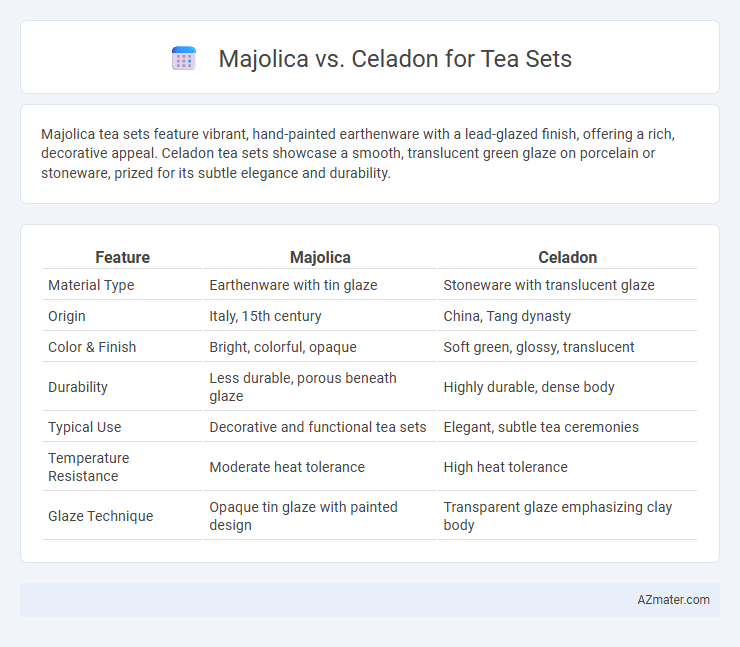Majolica tea sets feature vibrant, hand-painted earthenware with a lead-glazed finish, offering a rich, decorative appeal. Celadon tea sets showcase a smooth, translucent green glaze on porcelain or stoneware, prized for its subtle elegance and durability.
Table of Comparison
| Feature | Majolica | Celadon |
|---|---|---|
| Material Type | Earthenware with tin glaze | Stoneware with translucent glaze |
| Origin | Italy, 15th century | China, Tang dynasty |
| Color & Finish | Bright, colorful, opaque | Soft green, glossy, translucent |
| Durability | Less durable, porous beneath glaze | Highly durable, dense body |
| Typical Use | Decorative and functional tea sets | Elegant, subtle tea ceremonies |
| Temperature Resistance | Moderate heat tolerance | High heat tolerance |
| Glaze Technique | Opaque tin glaze with painted design | Transparent glaze emphasizing clay body |
Introduction to Majolica and Celadon
Majolica and Celadon are two distinctive ceramic styles popular in tea sets, each offering unique aesthetic and functional qualities. Majolica is characterized by its vibrant, colorful glazes and intricate hand-painted designs, often featuring floral or ornate patterns that enhance its decorative appeal. Celadon, known for its smooth, jade-green glaze and subtle crackle effect, embodies a minimalist elegance rooted in East Asian traditions, making it highly valued for both its beauty and cultural significance.
Historical Origins and Evolution
Majolica tea sets trace their origins to 15th-century Italy, characterized by tin-glazed earthenware with vibrant, opaque colors and intricate hand-painted designs. Celadon tea sets originated in ancient China during the Tang Dynasty (618-907 AD), renowned for their translucent jade-green glaze achieved through iron oxide in a reduction firing process. Both styles evolved through centuries, influencing European ceramics and adapting to cultural tastes while maintaining distinct glazing techniques and aesthetic traditions.
Key Characteristics and Visual Appeal
Majolica tea sets feature vibrant, opaque glazes with intricate, colorful patterns often inspired by nature, making each piece visually striking and rich in texture. Celadon tea sets are renowned for their translucent, pale green to blue-gray glazes that create a smooth, glossy surface with subtle crackle effects, offering a serene and elegant aesthetic. Both styles highlight craftsmanship but differ in visual appeal; Majolica emphasizes boldness and decoration, while Celadon delivers simplicity and understated beauty.
Material Composition and Production Techniques
Majolica tea sets are crafted from earthenware and feature a tin glaze that creates a bright, opaque white surface ideal for vibrant painted designs, employing a firing process at lower temperatures around 950degC. Celadon tea sets use stoneware or porcelain clay with an iron-rich glaze, subjected to high-temperature oxidation firing between 1200degC and 1300degC, resulting in a translucent, jade-like green or blue surface due to the glaze's chemical reaction. The distinct material compositions and kiln atmospheres distinguish Majolica's colorful, opaque finish from Celadon's smooth, translucent glaze, influencing their tactile feel and aesthetic appeal in tea ware collections.
Color Palette and Glazing Methods
Majolica tea sets feature vibrant, multicolored palettes achieved through opaque tin-glazing that creates a glossy surface ideal for detailed, hand-painted designs. Celadon tea sets exhibit soft, translucent hues ranging from pale green to blue-gray, produced by applying an iron-rich glaze fired in a reduction kiln, resulting in a smooth, jade-like finish. The distinct glazing methods influence both the visual texture and color intensity, making Majolica bold and decorative, while Celadon emphasizes subtle elegance and earthy tones.
Durability and Practical Use in Tea Sets
Majolica tea sets are made from tin-glazed earthenware, offering vibrant colors but lower durability due to their porous nature and susceptibility to chipping. Celadon tea sets, crafted from high-fired stoneware or porcelain with a translucent glaze, provide greater strength and resistance to thermal shock, making them more practical for daily use. The dense, non-porous surface of celadon also ensures better stain resistance and ease of cleaning, ideal for frequent tea service.
Cultural Symbolism and Artistic Significance
Majolica tea sets showcase vibrant, hand-painted designs rooted in Italian Renaissance traditions, symbolizing artistic exuberance and cultural opulence. Celadon tea sets, with their subtle jade-green glaze, reflect East Asian values of harmony, purity, and understated elegance, rooted in Chinese and Korean ceramic artistry. Both styles embody distinct cultural narratives through their unique aesthetics and historical significance in tea-drinking rituals.
Comparing Tea-Drinking Experiences
Majolica tea sets offer vibrant, multicolored glazes that enhance the visual appeal of the tea-drinking experience, while Celadon features subtle, translucent jade-like finishes that create a calming and refined ambiance. The porous nature of Majolica clay may slightly absorb tea flavors over time, enriching each brew with layered tastes, whereas Celadon's dense, non-porous surface maintains the pure, unaltered flavor of the tea. Heat retention also differs; Majolica tends to warm up quickly but cools faster, promoting faster consumption, while Celadon's thicker walls retain warmth longer, ideal for slow, mindful sipping.
Collectibility and Market Value
Majolica tea sets are prized for their vibrant, hand-painted glazes and intricate Victorian-era designs, often commanding higher auction prices due to their decorative appeal and historical significance. Celadon tea sets, favored for their smooth, jade-like glaze and subtle elegance rooted in East Asian craftsmanship, attract collectors interested in antiquity and cultural heritage, generally achieving strong market values especially for rare or antique pieces. Both types maintain steady demand, but Majolica tends to have more volatile market fluctuations linked to style trends, whereas Celadon appreciates consistently with provenance and age.
Choosing the Right Tea Set: Majolica or Celadon
Selecting the right tea set hinges on both aesthetic preference and functional qualities: Majolica tea sets boast vibrant, hand-painted designs with a glossy glaze that enhances durability and heat retention, making them ideal for lively gatherings. Celadon tea sets offer a serene, jade-like finish with a smooth texture and subtle translucence, prized for their elegant simplicity and ability to maintain tea temperature longer. Consider Majolica for a colorful, expressive presentation or Celadon for a minimalist, refined tea experience that complements traditional tea ceremonies.

Infographic: Majolica vs Celadon for Tea Set
 azmater.com
azmater.com